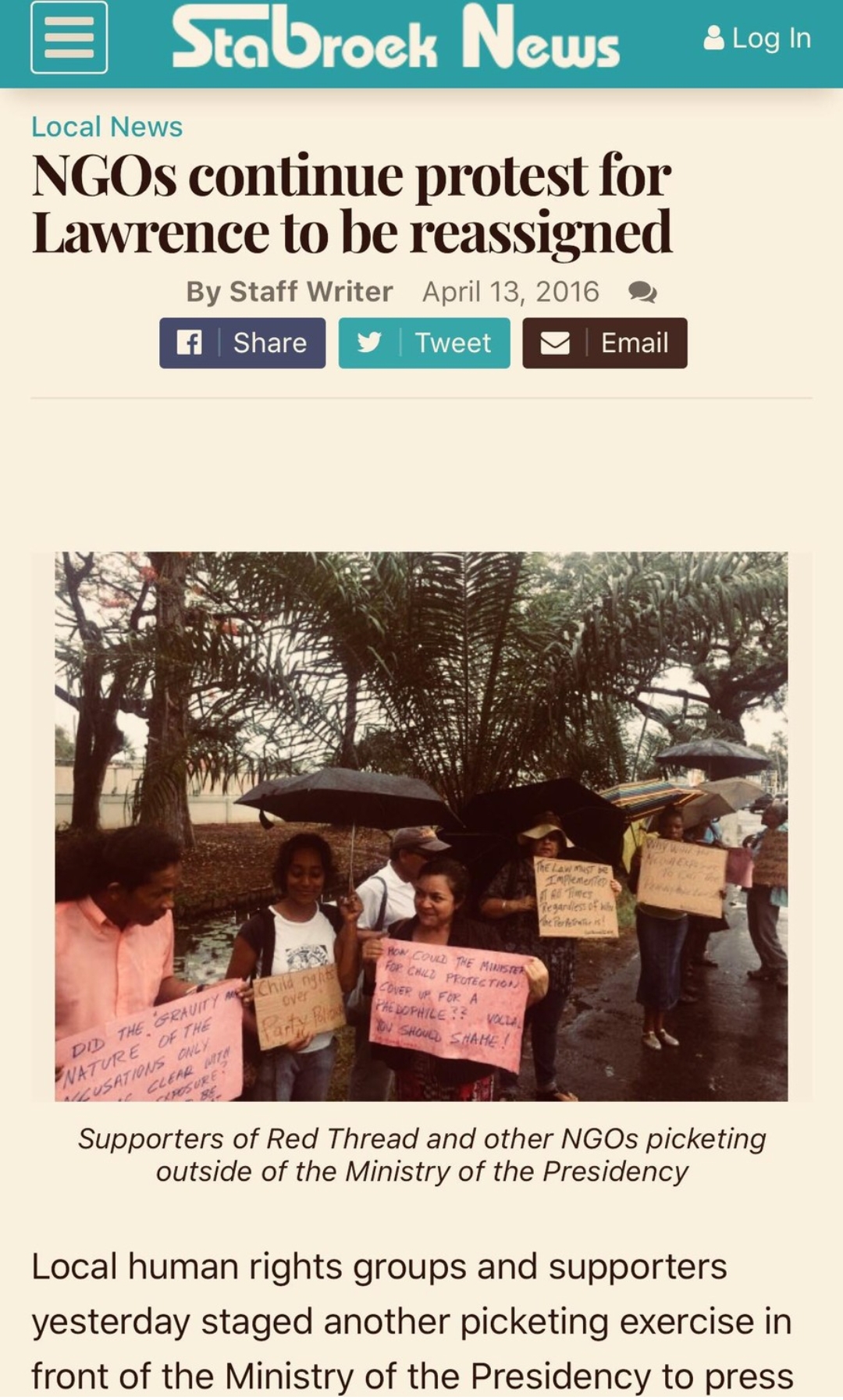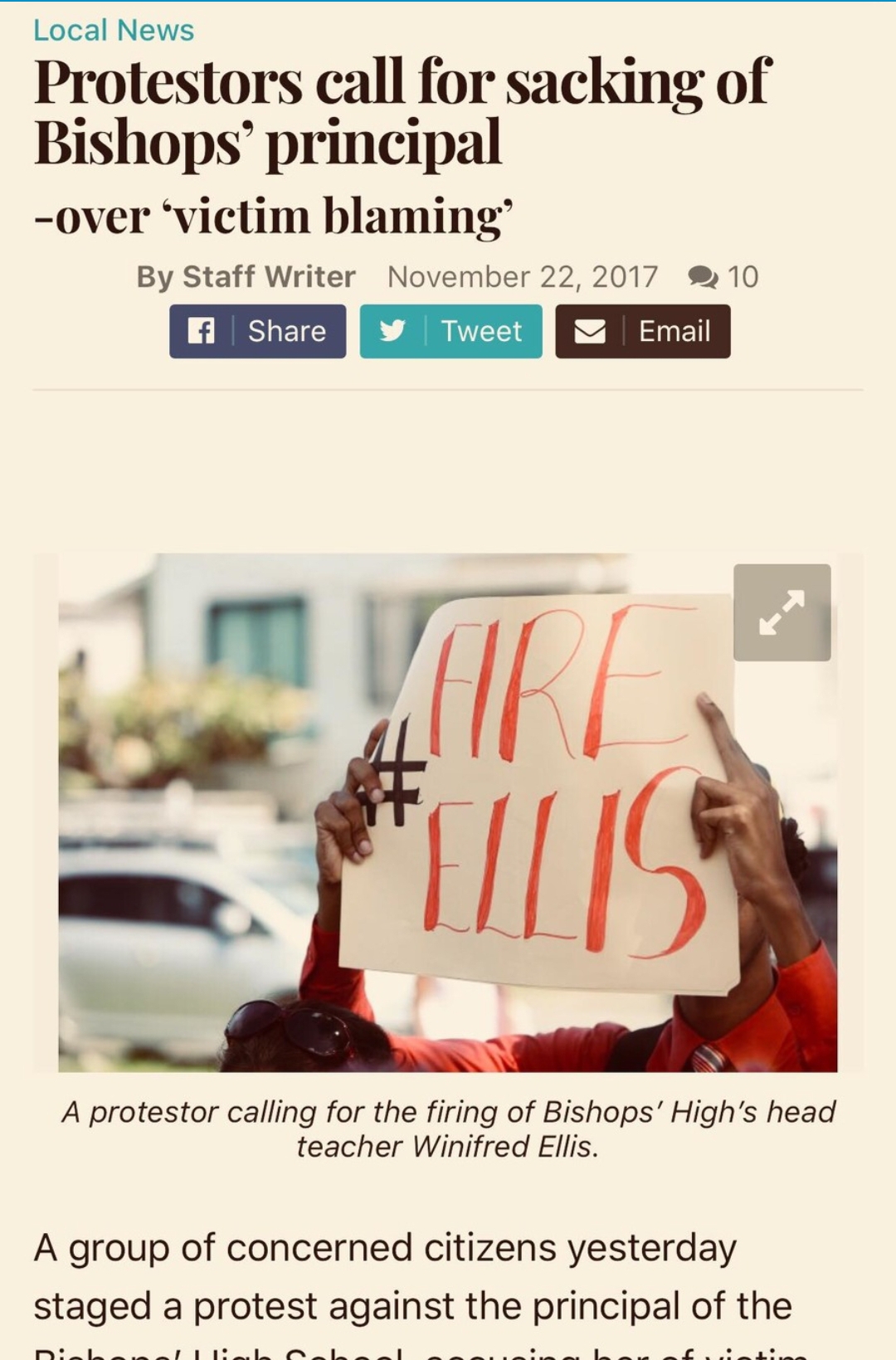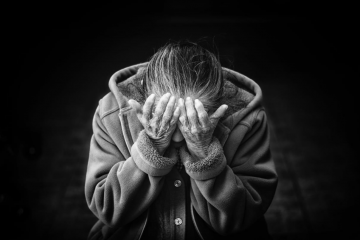(Previous version published in journal The Thinker, Vol.2, January 2019, by Anna Correia de Sá)
In recent years, Guyana gained notoriety for ranking among the top five countries with the highest suicide rates in the world, aquiring third place after Sri Lanka and Lithuania in 2017. According to the Small Arms Survey, it is also one of the countries most affected by violent deaths in 2016, including by sexual assault (for every 20 per 100 000 population). Sadly, if enough data and statistics on gender inequalities, violence and discrimination were available, a similar picture might depict the horrendous reality which challenges women and girls in this sparsely populated South American country. The UN ranks Guyana 122 out of 189 countries on the Gender Inequality Index (GII), far behind our English-speaking Caribbean neighbours for which data is available. Trinidad floats at 73, Barbados at 60 and Jamaica which ranks highest after Guyana, at 95. As a matter of fact, the countries which come immediately before us on the GII are Morocco, Guatemala and Ethiopia and those that come immediately after us are Iraq, Senegal, Zambia, Uganda and India. We moved from 114 in 2014 to 117 in 2016, before scaling down to 122 in 2017. Women remain underrepresented in politics and were it not for the legislative gender quota (33%) they might not have made it to the thirty per cent mark in Parliament. Though women comprise over 40 per cent of the labour force, expectant and nursing mothers are forced to put up with deplorable working conditions, due to a weak regulatory framework cobbled with the absence of political will to push for necessary reforms that would reduce gender disparities.
Despite national legislation which on paper provides for women’s rights, violence against women and girls (VAWG) remains pervasive, while their access to social and economic rights is stymied by the invisible barriers of taboos and stereotypes anchored in the Guyanese psyche itself. How much of the national budget actually goes to reducing gender disparities and promoting women’s and children’s rights, is not certain. This aspect of development is not widely documented and hardly any priority is given to assessing the impact of gender inequalities, abuse and discrimination against women on the overall human development of the country.
Numbers that speak
For a country with less than eight hundred thousand inhabitants, the ratios of femicide and abuse are alarming. Where official statistics are lacking, media and police reports paint a grim canvas of the dangerous environment in which Guyanese women and girls struggle every day. Gender-based violence (GBV) is widespread and is often the cause of fatal passionate and intimate partner crimes, incapacitating physical assault, sexual abuse and harassment, pedophilia and incest. Between 2011 and 2013, the Ministry of Public Security registered more than 9,200 cases of domestic violence, with 65% of them involving an actual assault. There were 1787 reported cases of domestic violence in 2017, with Regions 4, 5 and 6 accounting for 1245 alone. By the end of December 2017, the local media had reported 13 murders of Guyanese women (of which 9 were intimate partner crimes) and 1 murder of an 18-month-old girl. Of the 13 women ages 17 to 89, 7 lived in predominantly rural areas that are highly dependent on the agriculture sector. 7 murders occurred in Berbice and 6 occurred in Region 4 (mainly Georgetown). 2 of these women were married, 2 had separated from their husbands, 1 was in a common-law relationship, 3 were in relationships and 4 were over 70 years old with the eldest being 89. 1 of the senior citizens was murdered by her son while the 3 others along with the 18-month-old who was thrown out of a window and buried alive, were the victims of fatal robberies.
By the end of August, 2018, another 15 homicides had been recorded. Most of the victims ranged from ages 20 to 40. One of the more gruesome cases involved a man slaughtering his wife and gutting his eleven-year-old daughter before taking his own life. These murders do not include rape allegations or Guyanese women murdered abroad.
Sexual abuse is equally rampant. Police reports suggest an increase of 26% in the number of reported rapes from 2015 to 2016, with 300 reports at the end of November 2016 compared to 238 for the same period in 2015. Another 7% increase was recorded by October 2018, with 202 cases reported in 2018 compared to 189 in 2017. Young girls are not exempt from sexual violence. In 2017 there were 841 reported cases of child sexual abuse, of which 722 were girls. By May 2018, the Child Care and Protection Agency announced some 481 children victim of sexual abuse, of which 393 were girls. By the end of September, this number had already attained 604 reported cases.
A glimpse at how sexual abuse is treated in Guyana reveals that out of over 230 reports of rape in 2015, only 36 accused were actually charged. By March 5 2018, only 10 cases of sexual abuse were brought before the Georgetown Courts for victims of whom some were as young as 3. For the average citizen, this is hardly a surprise but instead an indicator of the consequences of institutionalized gender-bias. The police and authorities are often accused of trivializing rape allegations and domestic violence and in other instances, political connections and wealth supersede the law. At least 2 cases of femicide during the course of 2018 (both in Berbice) resulted from years of ongoing intimate partner violence (IPV) which were known to family members, neighbours and the Police.
Likewise, there are elected and appointed political leaders who held or continue to hold high offices in Government though they were accused of sexual harassment, abuse or gender-based discrimination. The case of a renowned Guyanese politician and TV station owner who allegedly raped a 9-year-old girl and escaped judgement, is one of many examples. Abuse against girl children is rampant. By mid-2018, the Child Care and Protection Agency had already announced a staggering 481 cases of child sexual abuse, of which 393 were girls. From January to March 5th, there were already some 400 reported cases of child abuse. The consequences are both physical and psychological trauma, with some girls ending up being burdened by life threatening pregnancies. Even if the necessary post-traumatic care is administered, the consequences of abuse can have a devastating impact on the social and economic growth and empowerment of girls.
Victims of discrimination and abuse generally cower in silence under the pressure of taboos and shame in their communities. The chronic lack of medical professionals especially in rural Guyana, limits access to professional help, forcing victims to bear the strain of emotional and psychological trauma alone, which can further degenerate into mental illnesses. There are approximately 10 or less trained psychiatrists in Guyana to deal with the overwhelming cases of mental illnesses and only 3 certified psychologists at the overcrowded Georgetown Public Hospital. Meanwhile, a 2014 World Health Organisation (WHO) report established a direct correlation between GBV (including child abuse) and high suicidal behaviour. The organisation found that women who experience intimate partner violence are also twice as likely to succumb to depression and alcoholism. The WHO also reports that about 38 percent of violence against and girls are committed by an intimate partner. For Guyana, the figures above suggest that at least 60 percent of homicides are committed by intimate partners.
Impact on development
Statistics show that the number of femicide cases is slightly higher in rural communities (particularly in the Berbice region for 2018) than it is in the more urbanized Georgetown and surrounding areas. Prevalence data is not readily available to determine with exactitude the extent of gender-based discrimination and violence in the hinterland (inhabited by indigenous populations mainly). FAO Deputy Director General, Daniel Gustafson, in an interview available on the organisation’s website, emphasized the link between poverty and food security, and GBV. He explained that GBV “in rural areas where the FAO operates (…) is pervasive”, having a consequential impact on food security. This scenario applies to the Guyanese context insofar as GBV is widespread and that a majority of the local population can be defined as rural and heavily dependent on traditional income earning sectors such as agriculture (rice, sugar, cash crops, fishing, etc.) and the extractive industry (gold, diamond, etc. in particular). The consequences on the economy, though not assessed by national institutions, can be alarming if we consider that gender-based violence can cause loss of lives, physical and mental disabilities, while creating orphans and depriving the country’s labour force of valuable human capital. The fact that a percentage of the murderers commit suicide after killing their partners augments the burden on the economy. Traumatized children who witness or are victims of GBV, generally go on to replicate negative behavioural patterns and contribute as adults to the cycle of chronic gender inequalities and violence which characterizes Guyana, especially since little opportunity for counselling and care exists.
The question of how we ended up here can be traced back to how leaders, national institutions and authorities, in over five decades of independence, have chosen to respond to gender inequalities. A closer look at policy-making in Guyana would reveal that the State’s protection services and response mechanisms are anaemic, neglected and overlooked in favour of more economic-driven priorities.
As a result, conscious and unconscious gender biases continue to permeate every stratum of society and for a wide cross-section of the population, including women, violence continues to be condoned as adequate punishment for disobedience or perceived immoral conduct. Like many others, our society is structured on patriarchal norms and values which have shaped gender and social relations for decades. The concept of reducing the gender inequality gap by formulating a rights-based approach to development therefore seems distant from political agendas. And ironically, the blame cannot be cast on men alone.
Women supporting benevolent sexism
A joint study published in August 2017 by the Australian Journal of Psychology, suggested that some women may support hostile or benevolent sexism because they prefer to be validated by male peers, and proceed to use their status and power acquired through their validation by the opposite sex as a means to exert social dominance over other women.
There are other women who choose to deliberately perpetuate a culture of gender inequality, thereby constituting an even greater threat to women’s empowerment. This includes emotional lynching and complacency in face of discrimination and transcends all layers of our social fabric, from the very bottom to the highest offices in Government. It is a women’s rights paradox manifested when women condone, encourage or justify abuse of other women – generally in cases of domestic and gender-based violence – on the distorted basis that something about the victim’s attitude, conduct or appearance was immoral or unconventional, subsequently warranting her demise. Nation-wide internet access and the popularization of social media outlets such as Facebook, have transformed into courts before which victims are stripped of their dignity and judged against the dictates of society. Here, cyber-bullying and emotional abuse are mistaken for freedom of expression. This is one factor that contributes to the increasing normalization of violence, constituting a travesty to technological progress and free speech, where some Guyanese women encourage virtual violence without grasping the detrimental impact this can have on our emotional health and development.
Higher up, policy-making can be described as lethargic at best when tackling the issue of gender inequality. Irrespective of the level of education our appointed leaders might have, some of them are more prone to maintaining the status quo while others have time and again sought to attenuate gender-based discrimination and turn a blind eye to sexual assault. Several Ministries in Guyana are currently spearheaded or co-managed by female Ministers who, despite being educated or having a history of public leadership roles, have done very little to bridge gender inequalities and, as the statistics indicate, make meaningful progress over the years.

Former Social Protection Minister Volda Lawrence, came under fire in March 2016 when she dismissed a case of incest as being a “family matter. During the national Child Protection Week, the said Ministry under Lawrence’s mandate issued a statement describing “incest and underage sexual activity in childhood” as the “deflowering” of children. Unsurprisingly, Lawrence angered several human rights bodies in the country which sparked protests demanding her removal from the Social Protection Ministry.
Meanwhile in the Guyanese highlands, Lethem’s Deputy Mayor was leading a fight for justice when she accused a senior political appointee, of sexual abuse. By 2018, Amna Ally was responsible for the Social Protection Ministry and under her mandate all efforts were made to hush the matter, coerce the victim into silence and later slut-shame her when she appeared in court. Although he was suspended from the senior government position he occupied, the alleged perpetrator continued more than a year later, to benefit from an attractive salary, benefits and regional accommodation perks before being transferred to Region 8 in the same capacity. Unsurprisingly, a written complaint (seen by GEPAN) alleging his “immoral conduct” was made husband of new alleged victim in Region 8 – coincidentally, Parker’s co-worker.
The response mechanism of the Communities Ministry consisted in merely transferring the problem from one under-developed region to the next, while the Social Protection Ministry turned a blind eye.
Similarly, Winnifred Ellis is still headmistress of the Bishops’ High, despite condoning the alleged sexual abuse of school girls whose security she is still tasked with guaranteeing today. When the story of a male teacher who allegedly abused several Bishops’ High school girls broke, the headmistress was caught on tape reprimanding female students for being “slack” and “loose”, before ordering them to “step out of the line” and reveal themselves before the school if they were victims. This can be described as an attempt to humiliate and, by extent, silence any other victim in the school. The head teacher’s response was a demonstration of her disrespect for confidentiality surrounding sensitive sexual abuse cases, in particular for minors. It reflects her reluctance at the time to protect victims and her visible inaptitude to provide a safe learning environment for students. Although public calls by both students and interest groups were made to have her removed, the Education Ministry believed that an apology to students sufficed. Sadly, Ellis was not quite unlike Minister Volda Lawrence who attempted to desensitize the act of rape, by decorating national discourse with politically correct and blurred expressions.

What next for tomorrow?
The notion of female inferiority has become so entrenched in the Guyanese psyche that many of us women have long since moved from resignation, to acceptance of our condition. The result is that mothers, victim of their own unconscious bias, maintain their children plugged into a system that glorifies the boy child. Daughters on the other hand, continue to be trapped within the confines of traditional gender limitations, in an oppressive environment that stifles dreams and growth and shackles freedom, often on the basis of misconstrued perceptions of morality. This explains why in one recent case of femicide, neighbours argued that the victim encouraged the recidivist behaviour of her husband by returning to him after every beating. The result of this mentality that has accepted the daily denigration of women, is that when a victim stands up to her oppressor, her right to justice is often determined by the society, based on their subjective judgement of her character and reputation.
How to go about tackling the scourge of GBV and gender inequalities depends largely on the political will to look beyond economically driven priorities. It is time to quantify the overarching devastating impact of systemic gender inequalities on sectorial progress, in order to formulate policies that adopt a comprehensive approach to both social and economic empowerment. Measuring the extensive contribution of the human capital of women to the economy, as well as their impact as economic agents, would serve as a formidable indicator of their value to our country’s development and support policies and regulatory frameworks that aspire to equal rights.
Achieving a gender-equal society would also require national institutions to take up their responsibilities in enforcing the existing legal framework that caters for women’s rights and security, as well as adopting the long overdue and the long overdue and much anticipated National Gender Policy which should also place emphasis on prevalence data collection. It is equally important that women with leadership and influential roles use their capacity to act, to address and tackle the laxity of national institutions, shape healthier attitudes, deconstruct social taboos and bring the national debate to the doors of policy-makers. Part of the solution to resolve gender-based discrimination, abuse and inequalities, requires acknowledging that some of us women are also part of the problem and must work to be the change we dream of.
Until then, newspaper pages will continue to run damp with the blood and tears of disenfranchised Guyanese women and girls.

